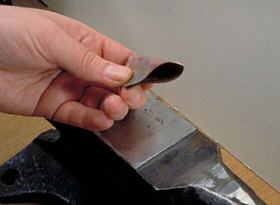Steps on Making a Rolled Fold Heistad Cup
Rolled folds are folds which utilize the rolling mill and it's unique properties of equal, directional pressure on the plastic metal. Many pleated folds work well as do a series of flattened T-folds of various types. This one demonstrates the fold-forming priniciple of This rolled fold is called a Heistad Cup.
2 Minute Read
Rolled folds are folds which utilize the rolling mill and it's unique properties of equal, directional pressure on the plastic metal. Many pleated folds work well as do a series of flattened T-folds of various types. This one demonstrates the fold-forming principle of this rolled fold Heistad Cup, after Earling Heistad who made the mental jump to this shape in an early workshop in 1985 in New Hampshire.
It is a truly magic fold, and one I use to introduce students to metal as their very first act in the jewelry studio. It takes only a few minutes to make.
Here are some images of a Heistad cup from different angles. Note there are many ways of folding up a cup, and this fold is just a starting point for this avenue of exploration.
You assume all responsibility and risk for the use of the safety resources available on or through this web page. The International Gem Society LLC does not assume any liability for the materials, information and opinions provided on, or available through, this web page. No advice or information provided by this website shall create any warranty. Reliance on such advice, information or the content of this web page is solely at your own risk, including without limitation any safety guidelines, resources or precautions, or any other information related to safety that may be available on or through this web page. The International Gem Society LLC disclaims any liability for injury, death or damages resulting from the use thereof.
Charles Lewton-Brain
Master goldsmith Charles Lewton-Brain trained, studied and worked in Germany, Canada and the United States to learn the skills he uses. Charles Lewton-Brain is one of the original creators of Ganoksin.
The All-In-One Jewelry Making Solution At Your Fingertips
When you join the Ganoksin community, you get the tools you need to take your work to the next level.
Trusted Jewelry Making Information & Techniques
Sign up to receive the latest articles, techniques, and inspirations with our free newsletter.
